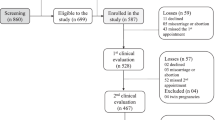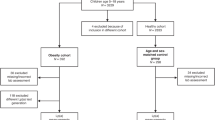Abstract
Background/objective
Low 25-hydroxyvitamin D levels [25(OH)D] may increase the risk for cardiovascular disease (CVD). In pregnant women excessive weight gain and 25(OH)D deficiency are common complications and both could have deleterious consequences on their children. We aimed to study the relationship between serum 25(OH)D and CVD risk factors in pregnant women and in their offspring at school age.
Subjects/methods
Fasting serum 25(OH)D and its bioavailable fraction were quantified in 310 healthy pregnant women [with adequate (n = 113), insufficient (n = 113) and excessive (n = 84) weight gain]. A follow-up at 5–6 years was performed in sixty-six children born of these mothers. Lipids, insulin, glucose, and high-sensitivity C-reactive protein (hsCRP) were measured in all subjects. Children’s carotid intima-media thickness (cIMT) together with visceral and intra-abdominal fat were measured by ultrasonography.
Results
Lower maternal 25(OH)D concentrations were associated with lower maternal age, and higher body mass index, triglycerides and hsCRP (all p < 0.05). In women with excessive weight gain during gestation, serum 25(OH)D concentrations showed independent associations with maternal hsCRP (β = −0.283 p = 0.03) and triglycerides (β = −0.436, p = 0.005). Maternal serum 25(OH)D concentrations were also independently associated with cIMT (β = −0.288, p = 0.04), visceral fat (β = −0.281, p = 0.01) and intra-abdominal fat (β = −0.248, p = 0.01) in their children at 5–6 years.
Conclusions
Lower serum 25(OH)D concentrations were related to CVD risk factors in pregnant woman and in their offspring. The cardiometabolic consequences of low 25(OH)D concentrations during pregnancy could be aggravated by excessive weight gain during gestation.
This is a preview of subscription content, access via your institution
Access options
Subscribe to this journal
Receive 12 print issues and online access
$259.00 per year
only $21.58 per issue
Buy this article
- Purchase on Springer Link
- Instant access to full article PDF
Prices may be subject to local taxes which are calculated during checkout
Similar content being viewed by others
References
Reichel H, Koeffler HP, Norman AW. The role of the vitamin D endocrine system in health and disease. N Engl J Med. 1989;320:980–91.
Ford ES, Ajani UA, McGuire LC, Liu S. Concentrations of serum vitamin D and the metabolic syndrome among U.S. adults. Diabetes Care. 2005;28:1228–30.
Peterlik M. Vitamin D insufficiency and chronic diseases: hype and reality. Food Funct. 2012;3:784–94.
Krivosikova Z, Gajdos M, Sebekova K. Vitamin D levels decline with rising number of cardiometabolic risk factors in healthy adults: association with adipokines, inflammation, oxidative stress and advanced glycation markers. PLoS One. 2015;10:e0131753.
van Schoor NM, Lips P. Worldwide vitamin D status. Best Pract Res Clin Endocrinol Metab. 2011;25:671–80.
Czech-Kowalska J, Gruszfeld D, Jaworski M, Bulsiewicz D, Latka-Grot J, Pleskaczynska A, et al. Determinants of postpartum vitamin D status in the caucasian mother-offspring pairs at a latitude of 52 degrees N: a cross-sectional study. Ann Nutr Metab. 2015;67:33–41.
Bodnar LM, Catov JM, Simhan HN, Holick MF, Powers RW, Roberts JM. Maternal vitamin D deficiency increases the risk of preeclampsia. J Clin Endocrinol Metab. 2007;92:3517–22.
Clifton-Bligh RJ, McElduff P, McElduff A. Maternal vitamin D deficiency, ethnicity and gestational diabetes. Diabet Med. 2008;25:678–84.
Morley R, Carlin JB, Pasco JA, Wark JD. Maternal 25-hydroxyvitamin D and parathyroid hormone concentrations and offspring birth size. J Clin Endocrinol Metab. 2006;91:906–12.
Miettinen ME, Smart MC, Kinnunen L, Harjutsalo V, Reinert-Hartwall L, Ylivinkka I, et al. Genetic determinants of serum 25-hydroxyvitamin D concentration during pregnancy and type 1 diabetes in the child. PLoS One. 2017;12:e0184942.
Wortsman J, Matsuoka LY, Chen TC, Lu Z, Holick MF. Decreased bioavailability of vitamin D in obesity. Am J Clin Nutr. 2000;72:690–3.
Crozier SR, Harvey NC, Inskip HM, Godfrey KM, Cooper C, Robinson SM, et al. Maternal vitamin D status in pregnancy is associated with adiposity in the offspring: findings from the Southampton Women’s Survey. Am J Clin Nutr. 2012;96:57–63.
Daraki V, Roumeliotaki T, Chalkiadaki G, Katrinaki M, Karachaliou M, Leventakou V, et al. Low maternal vitamin D status in pregnancy increases the risk of childhood obesity. Pediat Obes. 2018 https://doi.org/10.1111/ijpo.12267.
Straughen JK, Trudeau S, Misra VK. Changes in adipose tissue distribution during pregnancy in overweight and obese compared with normal weight women. Nutr Diabetes. 2013;3:e84.
Olson CM. Achieving a healthy weight gain during pregnancy. Annu Rev Nutr. 2008;28:411–23.
Carreras-Badosa G, Bonmati A, Ortega FJ, Mercader JM, Guindo-Martinez M, Torrents D, et al. Altered circulating miRNA expression profile in pregestational and gestational obesity. J Clin Endocrinol Metab. 2015;100:E1446–56.
Kennel KA, Drake MT, Hurley DL. Vitamin D deficiency in adults: when to test and how to treat. Mayo Clin Proc. 2010;85:752–7.
Powe CE, Evans MK, Wenger J, Zonderman AB, Berg AH, Nalls M, et al. Vitamin D-binding protein and vitamin D status of black Americans and white Americans. N Engl J Med. 2013;369:1991–2000.
Kim HY. Statistical notes for clinical researchers: effect size. Restor Dent Endod. 2015;40:328–31.
Karlsson T, Andersson L, Hussain A, Bosaeus M, Jansson N, Osmancevic A, et al. Lower vitamin D status in obese compared with normal-weight women despite higher vitamin D intake in early pregnancy. Clin Nutr. 2015;34:892–8.
Salehpour A, Shidfar F, Hosseinpanah F, Vafa M, Razaghi M, Hoshiarrad A, et al. Vitamin D3 and the risk of CVD in overweight and obese women: a randomised controlled trial. Br J Nutr. 2012;108:1866–73.
Sneve M, Figenschau Y, Jorde R. Supplementation with cholecalciferol does not result in weight reduction in overweight and obese subjects. Eur J Endocrinol. 2008;159:675–84.
Zittermann A, Frisch S, Berthold HK, Gotting C, Kuhn J, Kleesiek K, et al. Vitamin D supplementation enhances the beneficial effects of weight loss on cardiovascular disease risk markers. Am J Clin Nutr. 2009;89:1321–7.
Vimaleswaran KS, Berry DJ, Lu C, Tikkanen E, Pilz S, Hiraki LT, et al. Causal relationship between obesity and vitamin D status: bi-directional Mendelian randomization analysis of multiple cohorts. PLoS Med. 2013;10:e1001383.
Wood RJ. Vitamin D and adipogenesis: new molecular insights. Nutr Rev. 2008;66:40–6.
McCarty MF, Thomas CA. PTH excess may promote weight gain by impeding catecholamine-induced lipolysis-implications for the impact of calcium, vitamin D, and alcohol on body weight. Med Hypotheses. 2003;61:535–42.
Jorde R, Grimnes G. Vitamin D and metabolic health with special reference to the effect of vitamin D on serum lipids. Prog Lipid Res. 2011;50:303–12.
Emerging Risk Factors C, Kaptoge S, Di Angelantonio E, Pennells L, Wood AM, White IR, et al. C-reactive protein, fibrinogen, and cardiovascular disease prediction. N Engl J Med. 2012;367:1310–20.
Amer M, Qayyum R. Relation between serum 25-hydroxyvitamin D and C-reactive protein in asymptomatic adults (from the continuous National Health and Nutrition Examination Survey 2001 to 2006). Am J Cardiol. 2012;109:226–30.
Bellia A, Garcovich C, D’Adamo M, Lombardo M, Tesauro M, Donadel G, et al. Serum 25-hydroxyvitamin D levels are inversely associated with systemic inflammation in severe obese subjects. Intern Emerg Med. 2013;8:33–40.
Barrera D, Diaz L, Noyola-Martinez N, Halhali A. Vitamin D and inflammatory cytokines in healthy and preeclamptic pregnancies. Nutrients. 2015;7:6465–90.
Bo S, Pisu E. Role of dietary magnesium in cardiovascular disease prevention, insulin sensitivity and diabetes. Curr Opin Lipidol. 2008;19:50–6.
Marcotorchino J, Gouranton E, Romier B, Tourniaire F, Astier J, Malezet C, et al. Vitamin D reduces the inflammatory response and restores glucose uptake in adipocytes. Mol Nutr Food Res. 2012;56:1771–82.
Ding C, Wilding JP, Bing C. 1,25-dihydroxyvitamin D3 protects against macrophage-induced activation of NFkappaB and MAPK signalling and chemokine release in human adipocytes. PLoS One. 2013;8:e61707.
Gao D, Trayhurn P, Bing C. 1,25-Dihydroxyvitamin D3 inhibits the cytokine-induced secretion of MCP-1 and reduces monocyte recruitment by human preadipocytes. Int J Obes. 2013;37:357–65.
Karkeni E, Marcotorchino J, Tourniaire F, Astier J, Peiretti F, Darmon P, et al. Vitamin D limits chemokine expression in adipocytes and macrophage migration in vitro and in male mice. Endocrinology. 2015;156:1782–93.
de Souza WN, Norde MM, Oki E, Rogero MM, Marchioni DM, Fisberg RM, et al. Association between 25-hydroxyvitamin D and inflammatory biomarker levels in a cross-sectional population-based study, Sao Paulo, Brazil. Nutr Res. 2016;36:1–8.
Karras S, Paschou SA, Kandaraki E, Anagnostis P, Annweiler C, Tarlatzis BC, et al. Hypovitaminosis D in pregnancy in the Mediterranean region: a systematic review. Eur J Clin Nutr. 2016;70:979–86.
Stojanovic OI, Lazovic M, Lazovic M, Vuceljic M. Association between atherosclerosis and osteoporosis, the role of vitamin D. Arch Med Sci. 2011;7:179–88.
Morales E, Rodriguez A, Valvi D, Iniguez C, Esplugues A, Vioque J, et al. Deficit of vitamin D in pregnancy and growth and overweight in the offspring. Int J Obes. 2015;39:61–8.
Reinehr T, Kiess W, de Sousa G, Stoffel-Wagner B, Wunsch R. Intima media thickness in childhood obesity: relations to inflammatory marker, glucose metabolism, and blood pressure. Metabolism. 2006;55:113–8.
Carbone F, Satta N, Burger F, Roth A, Lenglet S, Pagano S, et al. Vitamin D receptor is expressed within human carotid plaques and correlates with pro-inflammatory M1 macrophages. Vasc Pharmacol. 2016;85:57–65.
Choi YK, Song SW, Shin BR, Kim JA, Kim HN. Serum vitamin D level is negatively associated with carotid atherosclerosis in Korean adults. Int J Food Sci Nutr. 2017;68:90–6.
Juonala M, Voipio A, Pahkala K, Viikari JS, Mikkila V, Kahonen M, et al. Childhood 25-OH vitamin D levels and carotid intima-media thickness in adulthood: the cardiovascular risk in young Finns study. J Clin Endocrinol Metab. 2015;100:1469–76.
Karlic H, Varga F. Impact of vitamin D metabolism on clinical epigenetics. Clin Epigenetics. 2011;2:55–61.
McKay JA, Mathers JC. Diet induced epigenetic changes and their implications for health. Acta Physiol. 2011;202:103–18.
Acknowledgements
FdZ is a Clinical Investigator of the Clinical Research Council of the University Hospital Leuven, Belgium. LI is a Clinical Investigator of CIBERDEM (Centro de Investigación Biomédica en Red de Diabetes y Enfermedades Metabólicas Asociadas). JB is an Investigator of the Miguel Servet Fund (National Institute of Health Carlos III, Spain). ALB is an Investigator of the I3 Fund for Scientific Research (Ministry of Science and Innovation, Spain).
Author contributions
GCB: participated in the design of the study, data acquisition and to the writing of the manuscript; CAB: participated in the acquisition of data and to the writing of the manuscript; LSA: participated in the acquisition of data and to the writing of the manuscript; APP: participated in the acquisition of data and reviewed the manuscript; FDR: participated in the acquisition of data and reviewed the manuscript; PSR: participated in the acquisition of data and reviewed the manuscript; FdZ: participated in the interpretation of data and reviewed the manuscript; LI: participated in the interpretation of data and reviewed the manuscript; JB: conceived the original idea, interpreted the data and reviewed the manuscript. ALB: conceived the original idea, interpreted the data and reviewed the manuscript.
Funding
This research was supported by grants from the Carlos III Institute of Health, Ministry of Economy and Competitiveness (Spain) (MS12/03239 and PI14/01625 to JB and PI16/01335 to ALB), co-funded by FEDER (European Regional Development Fund).
Author information
Authors and Affiliations
Corresponding authors
Ethics declarations
Conflict of interest
The authors declare that they have no conflict of interest.
Additional information
These authors contributed equally: Judit Bassols, Abel López-Bermejo.
Electronic supplementary material
Rights and permissions
About this article
Cite this article
Carreras-Badosa, G., Armero-Bujaldón, C., Solé-Amat, L. et al. Serum 25-hydroxyvitamin D and cardiovascular disease risk factors in women with excessive weight gain during pregnancy and in their offspring at age 5–6 years. Int J Obes 42, 1019–1028 (2018). https://doi.org/10.1038/s41366-018-0101-6
Received:
Revised:
Accepted:
Published:
Issue Date:
DOI: https://doi.org/10.1038/s41366-018-0101-6



